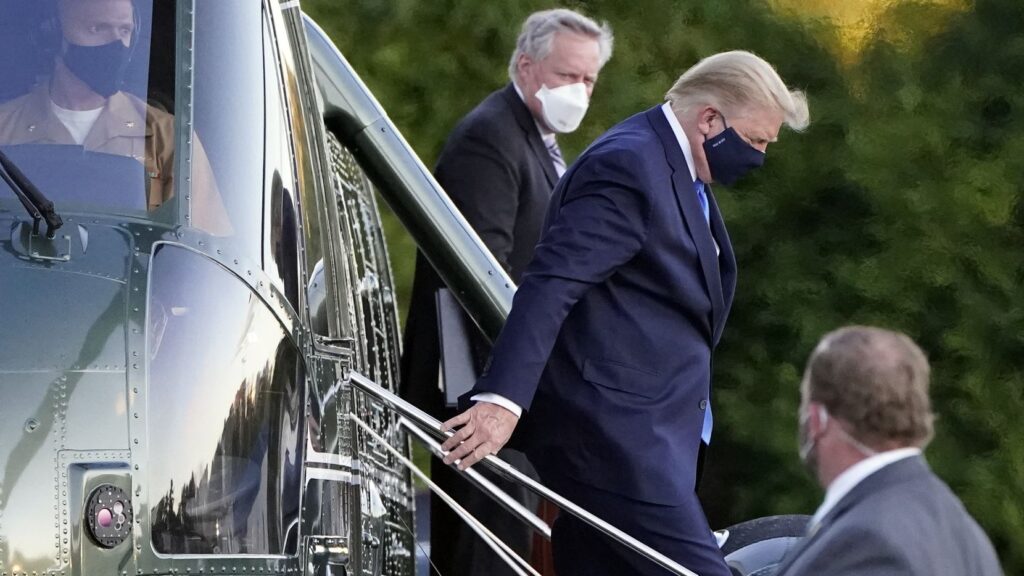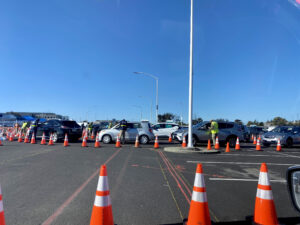Photographer: Jacquelyn Martin
Washington, D.C. – President Donald Trump returned to the White House on Monday, Oct. 5, three days after checking into Walter Reed Hospital to be treated for COVID-19. Trump’s symptoms were so alarming that doctors administered oxygen combined with several rounds of aggressive antibiotic treatment, USA Today reports.
Minutes prior to Marine One touching down on the South Lawn of the White House before 7 p.m. EST, Trump walked down the steps of Walter Reed Medical Center (WRMC) in Bethesda, Maryland, wearing a mask, not answering questions shouted by the journalist. Instead, he gave several thumbs up with a celebratory fist shake for the cameras gathered outside the building, the Washington Post reports.

“Thank you very much, everybody,” Trump said prior to boarding. Trump took to Twitter to advise his followers to not “be afraid of COVID. Don’t let it dominate your life. We have developed, under the Trump Administration, some really great drugs & knowledge.”
Trump received around-the-clock care at WRMC, including therapies not widely available to average patients experiencing mild symptoms, which was a combination of treatment options that treat the spread of COVID-19 throughout his body, assist with breathing and boost the immune system.
USA Today reports that hours after Trump arrived at the hospital, the White House released a memo from the president’s physician, Sean Conley, indicating Trump did not need to be put on oxygen but was starting remdesivir therapy (VEKLURY), which is used for hospitalized adults who need oxygen but are not sick enough to require ventilation. Conley noted that Trump was “doing very well,” and had completed his first dose while “resting comfortably.”
According to CNN, prior to being hospitalized, Trump received the biotechnology company Regeneron’s antibody cocktail for COVID-19 patients that is said to reduce levels of the virus and improves symptoms in patients. The experimental antibody therapy has shown promising results in a trial involving 275 patients. But the treatment has not yet received emergency use authorization from the Food and Drug Administration. Regeneron said they provided the drug after receiving a “compassionate use” request from Trump’s doctors.
In addition to the antibodies, CNN reports that one of the physicians treating Trump, Dr. Brian Garibaldi, said the President is being given the steroid drug dexamethasone as part of his COVID-19 treatment. This serves as an indication that Trump’s condition is worrying, as the drug should not be given to anyone who is not ill enough to justify the downsides of taking steroids. One of the major side effects includes suppressing the immune system.
“We decided that in this case the potential benefits, early on in the course, probably outweighed the risks at this time,” White House physician Conley told reporters outside WRMC on Sunday, Oct. 4.
ABC 6 News Philadelphia reports that Conley released a vague statement on the president’s condition in a letter, saying that Trump had a “restful” night at the White House and “he reports no symptoms.” On Monday afternoon, Oct. 6, shortly before his departure from WRMC, Conley offered that the president would not be “out of the woods” for another week.
The New York Times reports that back on Sept. 6, at least 11 people who attended a White House event have since tested positive for COVID-19. Eight of them, including the first lady, sat in the first several rows of a nomination ceremony for Judge Amy Coney Barrett in the White House Rose Garden. The crowded event is now coming under intense scrutiny, being labeled a “super spreader event” where its believed COVID-19 may have been introduced to White House staff.
USA Today reports that the White House rejected an offer from the nation’s public health experts to lead the effort in tracking down and notifying Americans who were exposed to the COVID-19 outbreak, that may be linked to Trump and several top aides on Monday, Oct. 5. In both interviews and internal Centers for Disease Control and Prevention (CDC) communications reviewed by USA Today, current and former agency officials accused the White House of intentionally avoiding learning the scope of the outbreaks linked to top White House officials. Without an independent investigation, they said, countless others may be exposed and never know it.
“CDC, when left in the hands of its scientists, makes tough decisions and helps implement them and maybe that’s not what the White House wants,” said Dr. Jeffrey Koplan, a former CDC director and 26-year veteran of the agency. “They seem to be marching toward a different goal. It’s a petty one and a partisan one. And all of us pay the price.”
USA Today reports that multiple sources within the agency stated that the White House Medical Unit declined an offer of assistance from the CDC’s leadership during a Monday morning phone call. CDC director Robert Redfield has been offering the agency’s help since Trump’s diagnosis was disclosed to the public.

Footage from the scene showed few attendees wearing masks. The seating was not set six feet apart, while some bumped fists, shook hands, or even hugged one another in greeting, BBC reports.
By Oct. 4, it was reported that eight people who attended the event were confirmed to have tested positive for COVID-19.
The New York Times reports that it is not clear when exactly the attendees who later tested positive were infected, and the White House has said all guests tested negative for the virus prior to the event. Still, it can take several days after exposure for the virus to be detected by a test. At the time this event was being questioned as “ground zero” for the White House. The following individuals have tested positive:
- New Jersey ex-Governor Chris Christie announced he tested positive for COVID-19 on Saturday, Oct. 3, Fox News reported.
- Kellyanne Conway, who resigned as Mr. Trump’s senior adviser in August, confirmed on Friday, Oct. 2 she had tested positive, according to BBC.
- Mike Lee, a Republican senator from Utah, confirmed his positive test on Twitter, as did North Carolina senator Thom Tillis.
- The University of Notre Dame confirmed their president, Reverend John Jenkins, also tested positive for COVID-19 according to NY Daily News.
- Three unnamed journalists who attended the event also tested positive for COVID-19, according to the White House Correspondents’ Association.
Ahead of the first presidential debate in Cleveland, Trump held closed-door preparation sessions with a half-dozen aides and advisers, including Bill Stepien, his campaign manager; Kellyanne Conway, a former White House adviser; and Chris Christie, the former governor of New Jersey. All of them have since tested positive for the COVID-19. Rudolph W. Giuliani, the president’s personal lawyer, also participated in debate preparation sessions but has said he tested negative, according to the New York Times.
Since the event in the Rose Garden, Trump traveled in close quarters aboard Air Force One to and from the debate in Cleveland and campaign events in Pennsylvania, Minnesota and New Jersey. At least five other people on those flights later tested positive, according to the New York Times. The first lady Melania Trump tested positive after the president’s communications director, Hope Hicks, tested positive for COVID-19, who did not attend the Rose Garden event.
The Associated Press reports that D.C. Mayor Muriel Bowser stated on Monday, Oct. 5, that the city “reached out to the White House on a political level and a public health level, to make sure that any assistance they could provide could be rendered.” The city has yet to hear back from the White House, Bowser said, while acknowledging that “a lot was going on and they have their hands full.”
“It would be useful to hear from the administration exactly how they are handling this so everybody could be reassured that it is being handled adequately and appropriately,” said Dr. Marcus Plescia, chief medical officer of the Association of State and Territorial Health Officials, according to USA Today. Experts said a prominent national outbreak is precisely when the CDC’s expertise would be expected to shine. The $7 billion federal agency was established to lead the nation through pandemics.
“In any normal administration, the CDC case investigators would be all over this,” said Jeremy Konyndyk, a senior fellow at the Center for Global Development, who helped lead the Obama administration’s response to the Ebola outbreak internationally. “This is why you have the CDC — to investigate clusters like this.”
News broke on Tuesday, Oct. 6 that the top U.S. general, Gen. Mark Milley, and several members of the Joint Chiefs of Staff are quarantining after a top Coast Guard official tested positive for COVID-19, several U.S. defense officials tell CNN. On Monday, the Vice Commandant of the Coast Guard, Admiral Charles Ray, tested positive after feeling mild symptoms over the weekend. The Coast Guard said in a statement that Ray recently attended several meetings at the Pentagon in secure areas with members of the Joint Chiefs. Those in quarantine include The Chief of Staff of the U.S. Air Force, Charles Brown; the Chief of Naval Operations Adm. Michael Gilday; and the Chief of Space Operations, Gen. John Raymond, who are also are all working from home, according to several officials.




